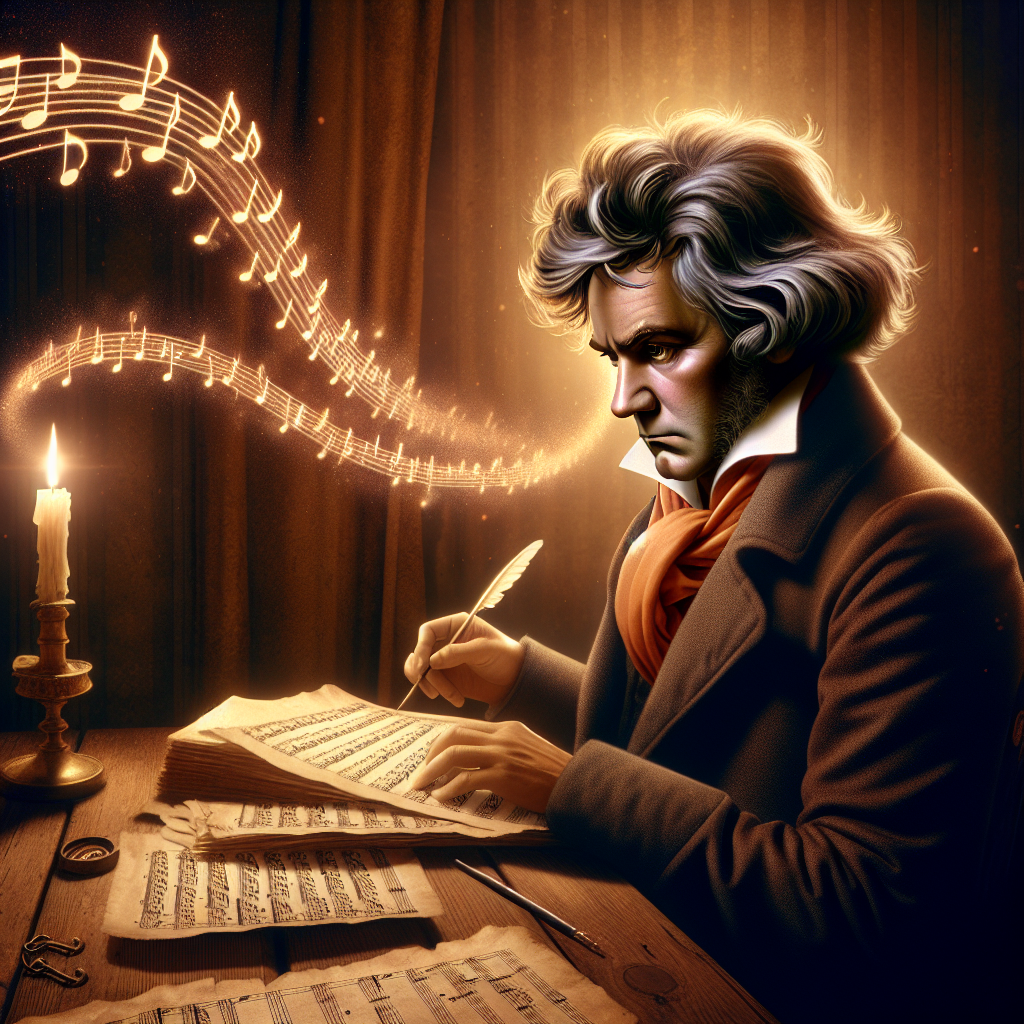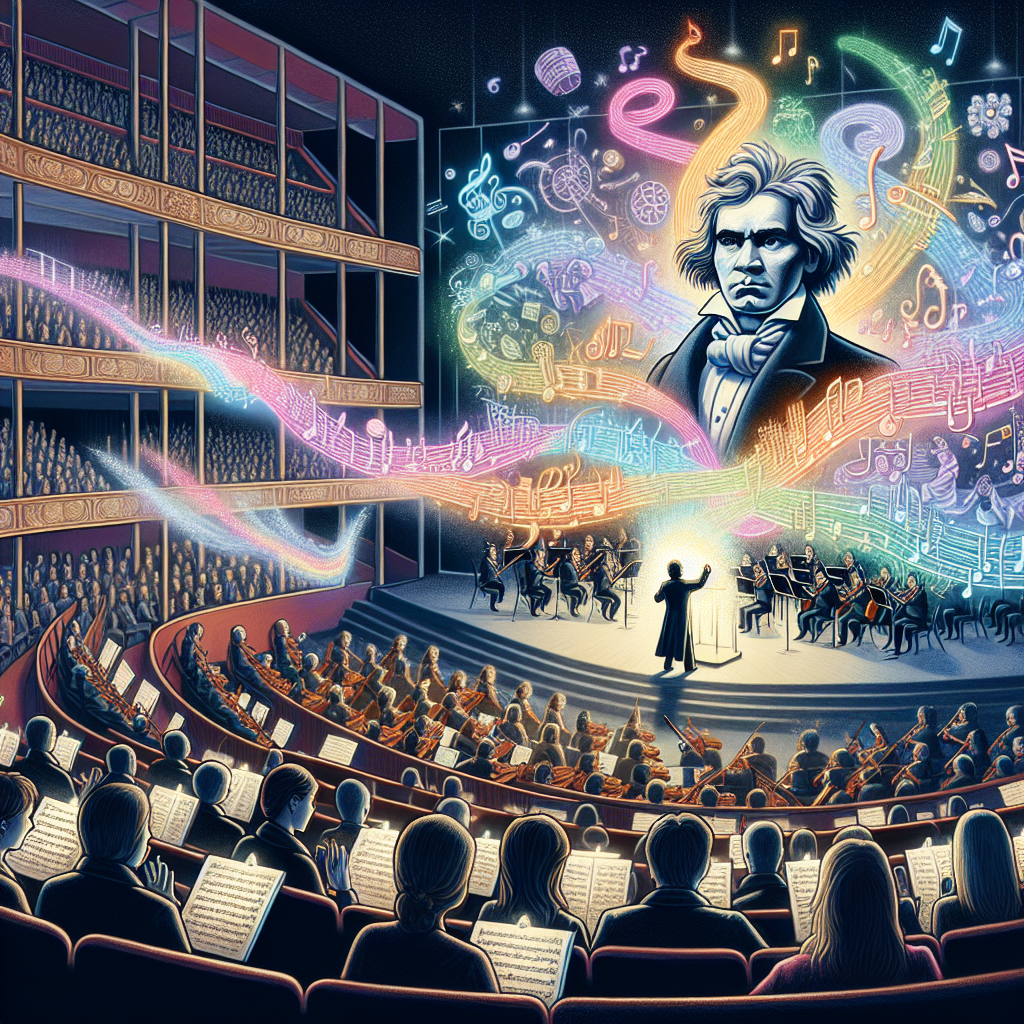
Beethoven and the Expansion of Musical Form
One cannot overstate the monumental influence Ludwig van Beethoven has had on the world of music. Born in Bonn in 1770 and relocating to Vienna in his early twenties, Beethoven was a composer who bridged the Classical and Romantic eras of Western music. Beyond his catalog of works, which include symphonies, sonatas, concertos, and quartets, Beethoven’s impact is often encapsulated in his revolutionary approach to musical theory and composition. His understanding of form, harmony, and musical structure was nothing short of transformative, and his compositions remain pivotal in both concert repertory and music education.
Beethoven’s ascent within the world of music was not without its struggles. Overcoming personal hardships, including a deteriorating sense of hearing, Beethoven’s resilience is just as noteworthy as his genius. His relentless pursuit of innovation challenged the conventions of his time, expanding the emotional and structural boundaries of music. For modern-day composers, musicians, and scholars, Beethoven’s works offer not only timeless enjoyment but also a rich repository of learning and inspiration.
This article delves into Beethoven’s life, his profound influence on music theory and composition, and how he expanded the traditional forms that had governed Western music for centuries. Whether you’re an aspiring musician or a casual appreciator of classical music, understanding Beethoven’s contribution can enhance your experience of his work and the broader cosmos of classical music.
Early Years and Inspirations
Beethoven’s early years were steeped in the rich musical traditions of his time, while his familial surroundings provided both a boost and a challenge to his budding talent. His father, Johann van Beethoven, served as a harsh mentor in young Ludwig’s formative years, hoping to shape him into a child prodigy similar to Wolfgang Amadeus Mozart. Although this ambition led to rigorous practice and sometimes severe discipline, it also ingrained in Beethoven a foundational proficiency in music.
In the early 1790s, Beethoven moved to Vienna, an epicenter of musical innovation, where he studied under the guidance of Joseph Haydn and later, Antonio Salieri and Johann Albrechtsberger. His time in Vienna influenced his musical style significantly, as he absorbed elements of Haydn’s clarity and balance, Mozart’s lyricism, and the contrapuntal rigors of the Baroque era. This exposure equipped Beethoven with the skills he needed to transform classical forms into something entirely new.
It’s also critical to note the political and philosophical impact of the Enlightenment on Beethoven. The ideals of liberty, equality, and fraternity, which resonated through Europe at this time, are reflected in his compositions, imbuing them with a sense of struggle and triumph that was both personal and universal. The revolutionary spirit of the time inspired Beethoven to innovate and break free from existing musical norms, laying the groundwork for his lasting legacy.
The Symphony: Redefining Structure and Emotion
One of Beethoven’s most significant contributions to music came in the form of the symphony. While symphonic form had been firmly established by composers like Haydn and Mozart, Beethoven took it to new heights. His nine symphonies each present a unique evolution in structure, emotional range, and technical challenge, ultimately redefining what a symphony could be.
Beethoven’s Third Symphony, also known as the “Eroica,” marked a turning point not only in his career but also in the history of music. This work expanded the size, length, and complexity of symphonies, incorporating daringly innovative elements such as abrupt modulations, extended development sections, and an unprecedented emotional depth. The “Eroica” Symphony is an embodiment of Beethoven’s vision of a heroic struggle, reflective of its original dedication to Napoleon Bonaparte before he declared himself Emperor.
The Ninth Symphony arguably stands as Beethoven’s magnum opus, introducing the human voice into the symphonic form through its choral finale, “Ode to Joy.” This bold integration of vocal and orchestral forces was groundbreaking, adding a dramatic dimension that had never been explored in previous symphonic compositions. The Ninth Symphony unfolded as a representation of universal brotherhood, further highlighting Beethoven’s alignment with Enlightenment principles.
The Sonata: A Canvas for Innovation
Apart from his symphonies, Beethoven’s sonatas—both for piano and other instruments—also served as a fertile ground for innovation. The piano sonata, in particular, saw a substantial evolution under Beethoven’s pen, becoming much more than a mere instructional piece for students. Instead, his piano sonatas emerged as profound artistic statements capable of exploring a vast range of emotions and ideas.
Take, for instance, the “Moonlight Sonata,” a piece that defies the traditional fast-slow-fast sonata structure. Instead, it starts with a slow, almost dirge-like first movement, followed by an equally emotional second movement, and culminates in a fast and tumultuous final movement. This unorthodox form flipped traditional expectations and showcased Beethoven’s willingness to prioritize emotional narrative over established norms.
The “Hammerklavier Sonata” (Piano Sonata No. 29) further pushed the boundaries of form and technical execution. This sonata is notable for its extraordinary range, structural complexity, and demanding performance requirements, pushing both pianist and instrument to their limits. It demonstrated Beethoven’s capacity to innovate continually, even late in his career.

Exploration of Harmony and Counterpoint
Beyond structure, Beethoven’s contributions to harmony and counterpoint were revolutionary. His Third Symphony showcased a range of harmonic innovations, shifting keys in ways that defied conventional expectations. Such bold harmonic choices infused his compositions with a richness and complexity that set them apart from those of his predecessors.
The “Grosse Fuge,” a work for string quartet, stands as a testament to his mastery of counterpoint. Initially part of his Op. 130 String Quartet, the “Grosse Fuge” was noted for its intense and intricate contrapuntal texture. Though it was bewildering for contemporary audiences and critics—who found it almost unplayable and difficult to understand—it is now hailed as a visionary exploration of polyphonic possibilities.
In the realm of harmony, Beethoven’s late string quartets further exhibit a harmonic language that was ahead of its time. These compositions explore a vast spectrum of tonal colors and dissonances, paving the way for the harmonic explorations of later Romantic composers and even the atonal movements of the early 20th century.
Beethoven’s Personal Struggles and Their Impact
It’s impossible to discuss Beethoven’s music without acknowledging the profound personal challenges he faced, particularly his progressive deafness. His awareness of his worsening condition started around 1798, and by the early 1800s, it became a source of deep despair, as evidenced by the anguished “Heiligenstadt Testament” he penned in 1802.
Remarkably, Beethoven’s hearing loss did not stifle his creativity. In some ways, it may have even enhanced his inner musical vision, freeing him from the constraints of contemporary performance practices. Without the distraction of external sound, Beethoven could delve deeply into the abstract essence of music, focusing on the expressive potential of pure musical ideas.
This personal adversity translated into compositions of unparalleled emotional depth and complexity. Pieces such as the poignant “Missa Solemnis” and the aforementioned Ninth Symphony were composed during his later years when his hearing was almost completely debilitated. These works reflect a profundity of spirit and a defiance of fate, encapsulating the essence of human resilience and creativity.
Influence on Future Generations
Beethoven’s impact on future musicians and composers can hardly be overstated. His innovative approaches to form, harmony, and emotional expression became a model and, in many cases, a challenge that subsequent composers would grapple with throughout the 19th and 20th centuries. The late Romantic composers, such as Johannes Brahms and Gustav Mahler, drew inspiration from Beethoven’s symphonic and harmonic innovations, incorporating emotional depth and structural complexities into their own works.
Even into the modern era, Beethoven’s influence endures. Contemporary composers and musicians continue to study and perform his works, finding new layers of meaning and technical mastery. The principles Beethoven established in his compositions can be seen in the works of avant-garde composers who explore the boundaries of tonality and form, such as Dmitri Shostakovich and Igor Stravinsky.
Moreover, Beethoven’s resilience in the face of personal struggles serves as a powerful narrative of triumph and artistic purity. His life and work remain a testament to the enduring power of music to transcend adversity and communicate the highest aspects of human experience.
Conclusion
In summation, Ludwig van Beethoven’s contributions to music theory and composition have left an indelible mark on the landscape of Western classical music. His revolutionary approaches to symphonic form, sonata structures, harmony, and counterpoint expanded the boundaries of what music could achieve, both technically and emotionally. The emotional depth and structural innovations within his compositions continue to inspire and challenge musicians and composers across the globe.
Through his personal struggles and unwavering creative vision, Beethoven not only redefined the possibilities within established musical forms but also forged new paths that subsequent generations would follow. His legacy is not merely one of great music but of a spirit that embodies the unyielding pursuit of artistic truth and the profound impact that music can have on human life.
From his early influences in Bonn to his monumental achievements in Vienna, Beethoven’s life story is one of constant evolution and relentless innovation. He remains a towering figure in the annals of music history, a beacon of inspiration for aspirant musicians and an enduring symbol of the triumph of human spirit through art.